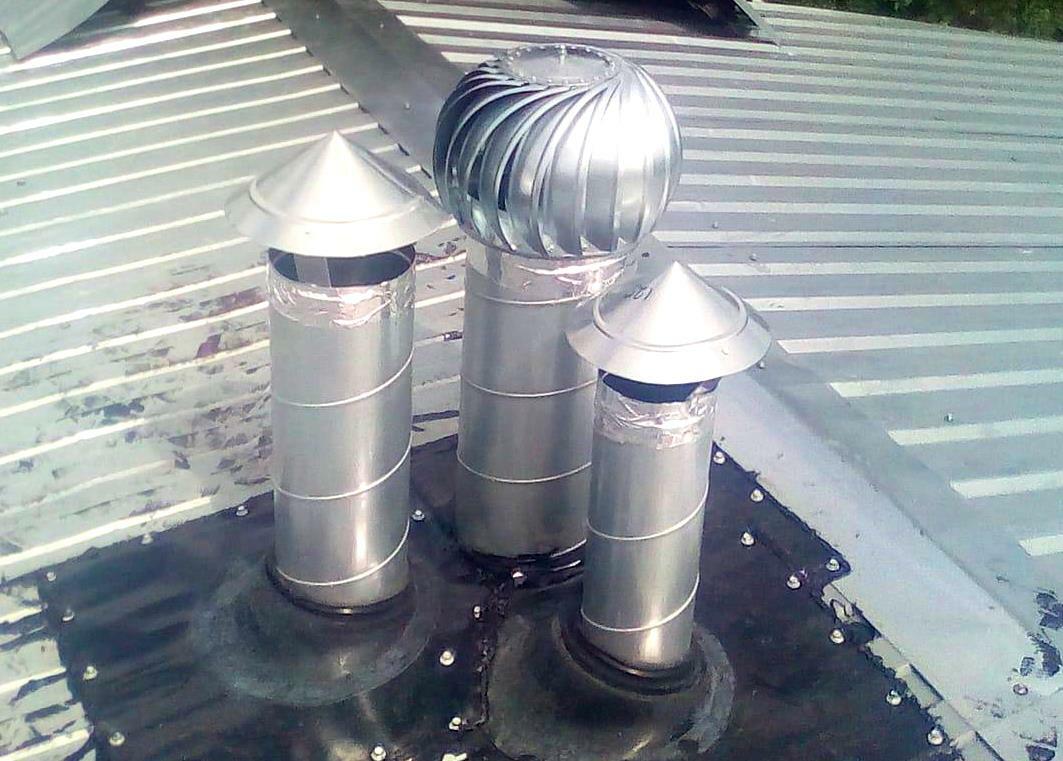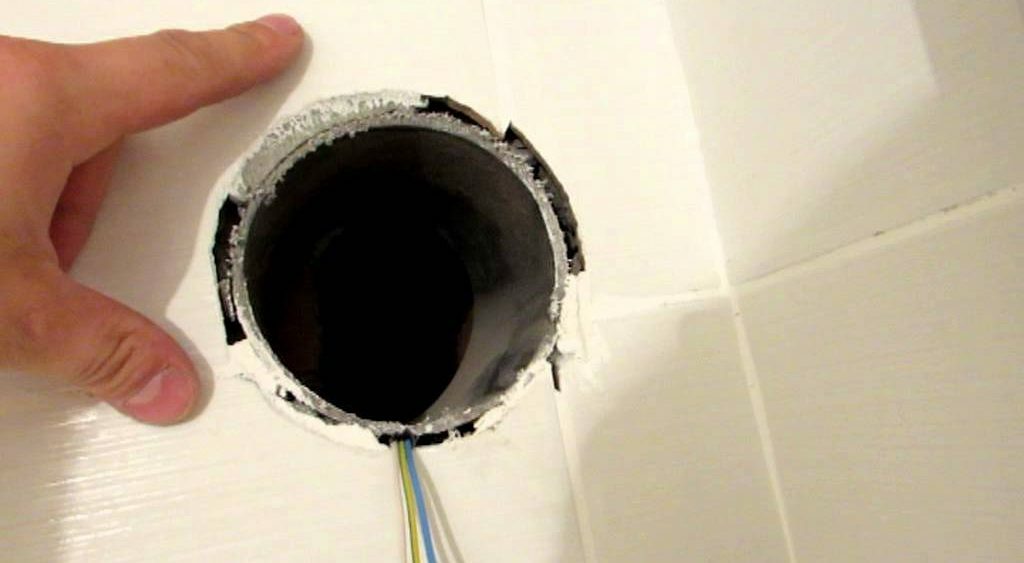It is better to consider ventilation and air conditioning issues even before building a house, at the design stage. Especially if you plan to install a built-in structure - for example, a duct system. This is a well-known fact.
If you are planning to build a house or make major repairs in an old house, it will not be superfluous to find out what a ducted split system is and how it works. The initial theoretical knowledge presented in this article will help you choose the right air conditioner, as well as understand its design and types.
You will learn all about the design specifics and the principle of operation of the duct climate equipment from the article presented by us. We will tell you about the varieties of this type of equipment used in air conditioning. Let's get acquainted with the technical characteristics and installation nuances.
The content of the article:
-
What are the channel split systems
- Design and principle of operation
- Types of built-in air conditioners
- Overview of technical specifications
- Advantages and Disadvantages in Comparison
- Conclusions and useful video on the topic
What are the channel split systems
There are many technically complex engineering communications solutions implemented in factory shops, multi-storey shopping and entertainment and sports centers. Most often these are multisystems equipped with additional devices and coupled with ventilation systems.
Efficient built-in air conditioning system has proven itself to be excellent in service industrial, public, entertainment institutions, the main feature of which is big square. But now it is often used to equip private cottages or apartments with high ceilings.
We will dwell in more detail on channel split systemssuitable for domestic use - they are simpler in design, smaller in size, but the basic principles of operation are the same.
Design and principle of operation
Channel-type air conditioners are designed, like other similar structures, to maintain a comfortable indoor climate. Their peculiarity is that they are designed to serve large areas, which are often divided into separate segments.
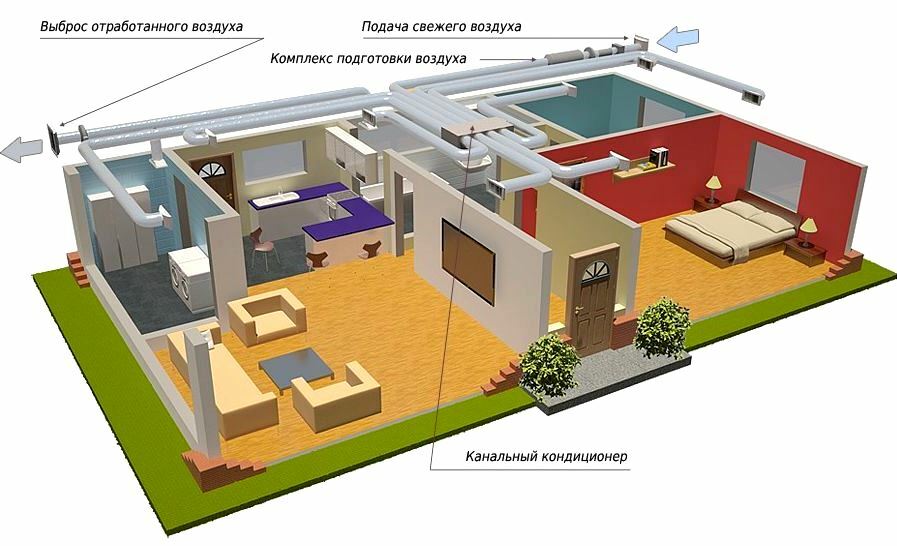
A duct split system is an expedient solution for a private house of permanent residence, in which a place for the installation of a built-in air conditioner was initially thought out
On the market you can find many offers designed specifically for private use - designed for 4-5 rooms, limited length and capacity.
The design of the duct air conditioner completely repeats the structure of a traditional split-system: one unit is mounted inside the building, the second - outside. The main difference is that the internal structures are located above the suspended ceilings, and not just fixed to the wall. There are models that can easily be placed in a closet, as well as air conditioners built into the wall.

The design of the channel split system, consisting of 2 blocks. Communication between parts is maintained using freon communications and electrical wires
The outdoor unit is of standard size and design. It contains the nodes responsible for cooling and uninterrupted operation:
- chokes;
- compressor;
- condenser with heat exchanger;
- fan;
- air filters;
- sensors;
- automation;
- elements of the failure notification system.
Some models that require large amounts of condensate to drain are fitted with a drain pump.

The unit is mounted on brackets directly from the outside of the wall or installed on a solid base, protecting it from ultraviolet radiation and precipitation
It is important to maintain the manufacturer's recommended installation height difference so that there are no technical problems after start-up. Internal ducts look different depending on the serving area and tasks.
But the filling of the indoor units is about the same:
- evaporator with heat exchanger;
- fan;
- condensate trap;
- electronic board with sensors.
The small number of work items is justified by minimizing noise in the living space. All parts are assembled in a sturdy case, which is disguised behind false partitions and ceilings.
Many people choose built-in "invisible" air conditioning systems because of the installation method and aesthetics: only grilles for air intake or discharge go outside.
The fan of the duct device has a high power. Unlike the conventional axial model, through which air passes freely, it must move volumetric flows with increased aerodynamic resistance.
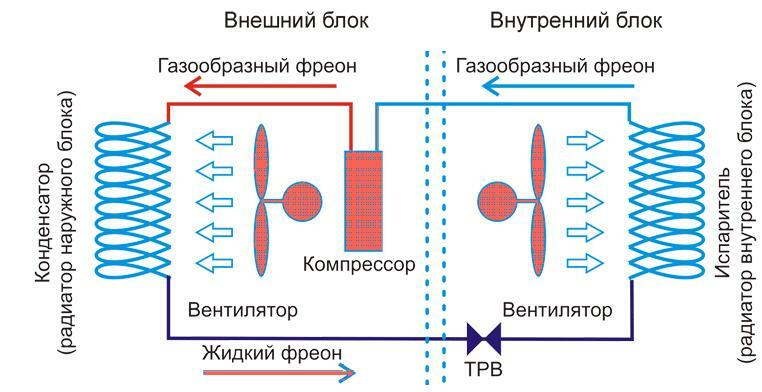
The principle of operation is based on the movement of the refrigerant, the operation of the heat pump and the condenser. Freon circulates in a closed loop between two radiators, internal and external, thanks to the built-in compressor
In the outer part of the circuit there is a throttle that compresses the gas. As a result, the gas condenses - it turns into a liquid. When it gets inside the room, it finds itself in a low pressure zone, heats up, evaporates and turns into a gas state again. Thus, the outer radiator is called the condenser and the inner one is called the evaporator.
A feature of the system is the transfer of heat due to the conversion of freon from the gaseous phase to the liquid and vice versa. In cooling mode, the evaporator coil lowers the room temperature.
But some modern systems work according to a double scheme, that is, during the cold period, on the contrary, they can increase the temperature inside the building, of course, within limited limits. Restrictions depend on the outside temperature. The maximum parameters are usually indicated by the manufacturer in the operating instructions.
Types of built-in air conditioners
Duct split systems are classified according to different technical parameters, but the main one is the head or pressure, which is measured in Pascals.
By the force of the pressure, the structures are divided into 3 groups:
- Low head - up to 40-50 Pa.
- Medium head - up to 100-150 Pa.
- High pressure - 250-300 Pa and more.
Low-pressure systems are the cheapest and easiest to install. They are installed in household premises, offices, private houses. They are often installed behind cladding panels in corridors and hallways, spacious halls and living rooms.

Air for the conditioning process, if there is no admixture from the street, is taken directly from the room where the equipment is installed - for example, from the hallway
Medium-pressure structures are more complex, they already require a pump to drain the condensate. They provide greater air circulation by mixing in air from the street.
Medium-pressure structures are installed in large cottages, shops, warehouses, training and sports centers.
The most powerful high-pressure systems are designed to serve a large number of spacious halls. They are equipped with an extensive network of air ducts, sophisticated electronics and many sensors.
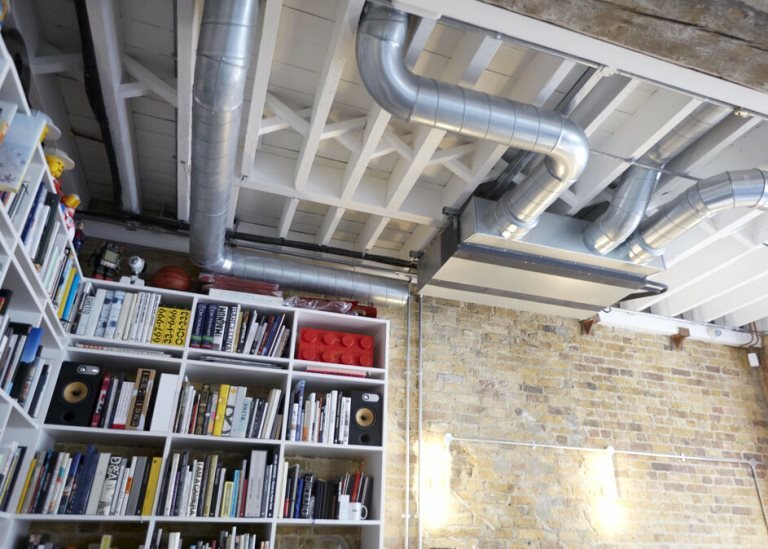
High-pressure systems are installed in restaurant halls, cinemas, hospitals, factories, multi-level supermarkets and large sports centers
Also, channel air conditioners are divided into:
- ordinary;
- inverter.
The compressor operation of conventional systems is not regulated, so they always operate with the same power, and to control the indoor microclimate, a simple automatic shutdown. For this reason, this equipment is also called "Start / Stop".
The name of the inverter systems appeared together with a new element in the design - the inverter, which allows you to smoothly change the power.

Inverter models, unlike conventional ones, do not turn off, but work in a constant mode that sets the optimal power. Parameters change depending on the indoor temperature
Developers advertise inverter models, often exaggerating their benefits. They argue that newer generation equipment is economical, quieter and more reliable. But no one conducted tests and there are no definite statistics on this score.
Both models are quiet - after all, all "noisy" processes take place in the outdoor unit, on the street. All types of equipment serve for a long time and, over time, need only partial replacement of parts. There is a lot of controversy over energy efficiency because, unlike inverter air conditioner, a conventional split system periodically shuts down and does not waste electricity.
But it is already becoming clear that the future belongs to inverter split systems. It is on the expansion of this assortment that the leading manufacturers are focusing.
There are other ways of dividing channel air conditioners into types:
- by appointment (home and industrial);
- by service area;
- by the availability of additional features, for example, the ability to mix air.
Some classifications are invented by manufacturers - thanks to them, buyers make a choice faster.
Overview of technical specifications
Now let's consider what characteristics affect the quality of the ducted air conditioner. Knowing the exact selection criteria, you can significantly narrow your choice.
Like any volatile system, channel split systems have a lot of technical data that require attention during purchase and installation. Let's note the most important ones:
Image gallery
Photo from
Modern inverter equipment operates in a constant mode, automatically maintaining the desired temperature inside the room and heating up to -25 ° C outside. Analogues from the On / Off category are not designed for such low limits and are usually designed for temperatures down to -5 ° С
The length largely depends on the head parameters. The more powerful the system, the longer the pipelines. It is important to know the length of the equipment to be installed in advance in order to correctly calculate the installation of pipes and cables. It is impossible for the distance between the blocks to be greater than that specified by the manufacturer.
If we take the power of a structure in heating or cooling mode and correlate it with energy consumption, then we get an energy efficiency class. For example, devices with a ratio of 3.0-3.2 belong to high class A, 2.8-3.0 - to class B, etc. For a home, it is preferable to buy systems of one of these classes - A, A +, A ++
To simplify the choice of the buyer, manufacturers indicate not only the power or the amount of pressure, but also the total area of the premises for which the split system is designed to be serviced. This figure is approximate, so other characteristics must be taken into account, including the number of channels and the average winter temperature.
This indicator is important for devices with supply. It is expressed in m³ / min and shows how much air flows through the system in 1 minute. Do not forget that even such trifles as the number of bends in the supply air ducts can greatly affect the final value.
Cooling and heating capacity will tell you whether the capacity of the air conditioner is enough to service the area of the house. It is believed that for every 10 m², 1 kW of power is required, therefore, for a 30-meter hall, 3 kW is needed. To determine the total power, you need to add up the area of all rooms
The internal fan is much quieter than the external one. Also, suspended structures with thermal insulation or false panels have a positive effect on noise reduction. For home installation, systems are preferable, the noise level of which does not exceed 30 dB, but you need to focus on the maximum indicator
Additional features increase functionality, but sometimes complicate maintenance. Modern systems are equipped with remote controls, can operate in dehumidification or ventilation mode, without cooling or heating. Very convenient designs with a timer, allowing you to customize the operating time
Inverter or lack thereof
Maximum length of communications
Energy Efficiency - Energy Class
Serviced area
Maximum air flow
Heating and cooling power
Indoor unit noise
Additional options and capabilities
You also need to pay attention not only to the length of air ducts, pipes or cables, but also to the dimensions of the duct air conditioner units.
Need to find a place to external blocksuitable for the installation conditions, as well as calculate the space in the room, so that, if necessary, you can service the "stuffing" of the module. Ultra-narrow models are also produced, specially designed for installation in living rooms.
An anti-icing system, a system for directing air masses, a function for storing user-set settings, and fan speed control are welcome.
Advantages and Disadvantages in Comparison
Duct systems are popular with everyone who cares about a comfortable atmosphere inside the house and at the same time tries not to flaunt all communications.
Air conditioning experts and regular users point out the following advantages to using duct equipment:
- there is no indoor wall unit that requires space on the wall and often does not fit into the interior design;
- installation of the system accompanies good air exchange in all areas of the house;
- a powerful indoor unit can serve several small rooms;
- the noise from the operating elements is minimized as much as possible.
When installing a duct system, you can combine it with ventilation, while saving both on the purchase of equipment and on installation.
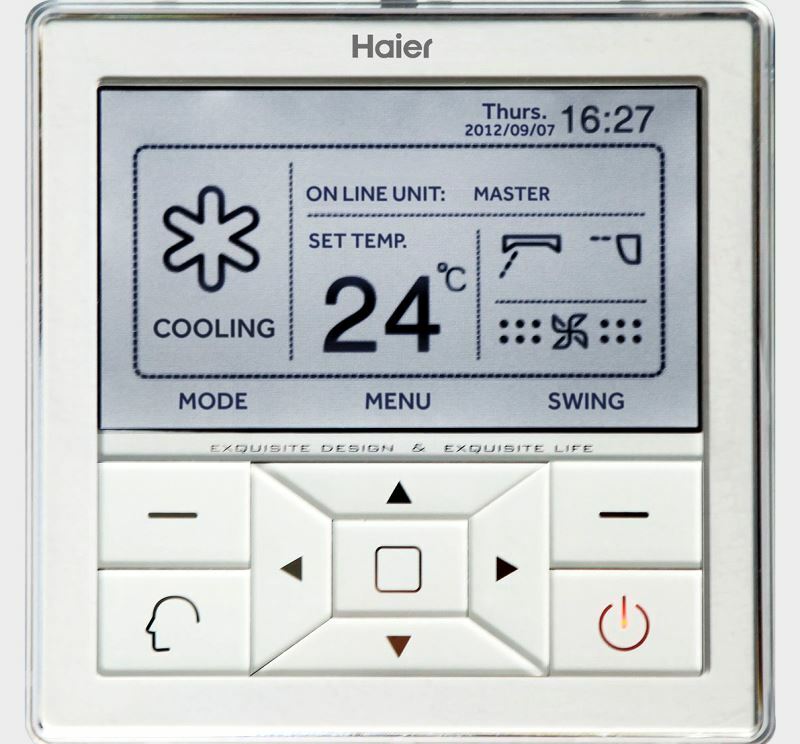
Modern air conditioning systems have different controls, but it is most convenient to use the remote control. With it, you can select the mode, change the internal temperature, adjust the fan speed
But there are also disadvantages that sometimes persuade home owners to install traditional wall split systems that are equally effective, but easier to install.
The disadvantages include:
- complex, requiring additional knowledge and professionalism, installation;
- arrangement of suspended structures for masking channels;
- the impossibility of creating different temperature regimes in neighboring rooms - the temperature will be the same everywhere.
But the main problem seems to be competent design, selection, calculation and installation of the structure. It is clear that these are additional costs, and considerable. If the system is improperly installed, the minimum annoyance will be loud noise echoing throughout the house, and the maximum will be a costly rework.
Conclusions and useful video on the topic
General information about duct air conditioners:
Theory and practical experience:
An example of installing a split-channel system in a city apartment:
For a standard urban "kopeck piece" with 2.5 ceilings or a small country house, which is more often used seasonally, during the warm season, the channel system is not needed. But for a spacious apartment with high ceilings or a cottage, a duct-type split-system can be the best solution for improving the microclimate in the rooms.
To install the equipment, you will have to make friends with locksmiths and installers; you cannot cope with the installation of a technically complex unit on your own. It will come out much more expensive than a conventional split system. But the result will be higher - you will get a reliable structure that provides you with coolness, warmth or just fresh air when you need it.
Want to talk about how your ducted air conditioning system works? Do you have any useful information on a topic that is worth sharing with your site visitors? Please leave comments in the form below, post a photo and ask questions.
